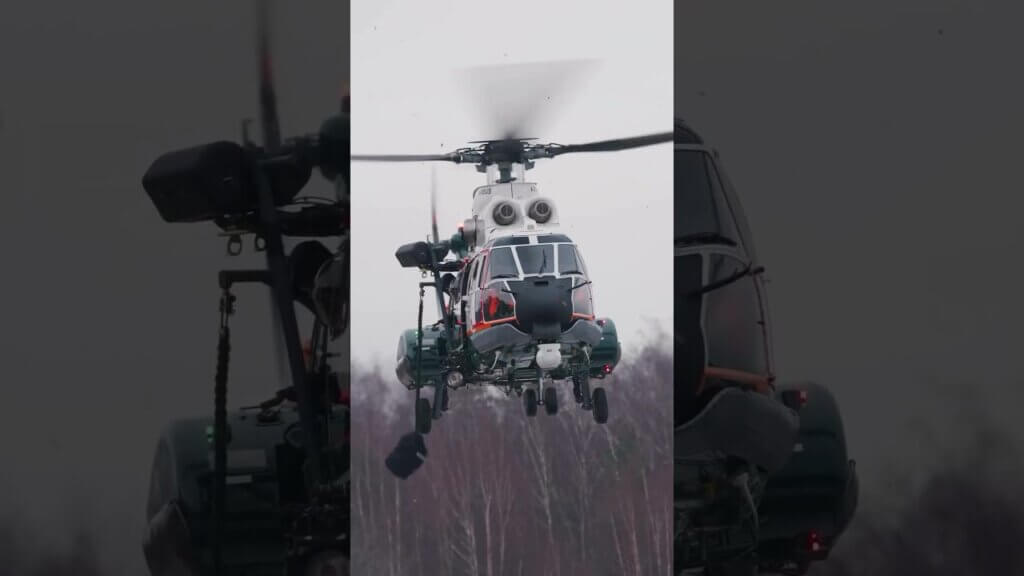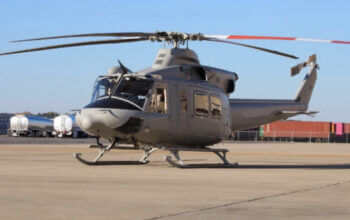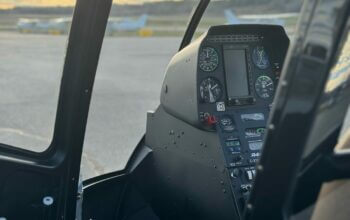The Austin-Travis County EMS STAR Flight helicopter program was selected on Tuesday as the outstanding Texas air medical provider EMS program, and recognized at the annual Texas EMS Conference in Dallas. The award was based on material submitted to a selection committee from DSHS (Texas Departments of State Health Services).
Long time Austin-Travis County EMS employee and STAR Flight Medic Jim Allday submitted the winning material to DSHS for the STAR Flight program. Here is Jim’s award winning nomination:
“Austin-Travis County EMS’s STAR Flight (Shock Trauma Air Rescue) is uniquely positioned in the air medical industry. At inception, in 1985, the STAR Flight program was a partnership between Travis County EMS, City of Austin EMS, and the city-owned and operated Brackenridge Hospital to establish an air medical program primarily to serve the rural areas of Travis County. Travis County funded the aircraft, aviation personnel (pilots and mechanics) and maintenance expenses and was the part 135 certificate holder. The City of Austin EMS department provided the flight paramedics, communications center, and the medical equipment. Brackenridge Hospital provided the flight nurses, crew quarters, and aviation facilities at the hospital (helipad and fuel system).
Within only several months, however, as STAR Flight was being requested both within and outside of Travis County for a variety of missions including rescue work, law enforcement assists, and fire suppression, these multiple requests for assistance demonstrated that STAR Flight was no longer simply a Travis County asset, but instead had become a Central Texas asset.
In the fall of 1999, discussions began at the highest levels of the City and County governments regarding the structure, staffing, mission and operation of STAR Flight. As a result of these discussions, all employees, including the medical crew, pilots, mechanics and administrative staff were placed under one organization and command chain. The flight crews were also “battle-rostered” such that the same pilot, paramedic, and nurse always worked together. The new organizational structure created an environment that allowed the STAR Flight crews the ability to work with a common direction and allowed the program to be proactive in the ever changing air-medical/rescue environment and to focus improvement efforts on program safety and the customers and patients we serve.
Over the years, the STAR Flight program has utilized a variety of helicopters in response to safety concerns and mission needs. The original aircraft were a new Bell 206L as the primary and a new Bell 206 as the backup. In 1990, with the approval of the Travis County Commissioners Court, we received a new Bell 412SP as our primary aircraft and the smaller Bell 206 was sold. With the Bell 412SP we now had an aircraft with twin engines, additional flight capabilities, greater working room in the patient area, and we become more effective on helicopter rescue missions.
In December 1998, we received two new Eurocopter EC135s to replace the aging Bell 412SP and 206L models. The EC135s had new technology as well as increased performance and efficiency. Several benefits of this acquisition included: two aircraft of the same type, no decrease in mission capability when one aircraft was down for maintenance, and two aircraft that were designed with public safety air rescue missions in mind. This contributed to decreased preparation time (and quicker on-scene times) for both medical and rescue missions.
And recently, in the spring of 2006, we received two new Eurocopter EC145s to replace the now aging EC135s. New developments, including Specialty Team transport and additional safety considerations, demonstrated the need for larger helicopters with additional capabilities. The new aircraft are equipped to meet STAR Flight’s multiple current and future mission profile: single-pilot IFR certified, color weather radar, storm scope, moving map display, rescue hoist, dual cargo hooks, and a drop-down wheeled primary stretcher. The new aircraft are also night vision compatible, and later this year, the program will be NVG certified for part 135 operations.
Originally, a hangar at the local airport was leased for space to work on each aircraft and to house the aircraft during inclement weather. In June 1999, we moved from that facility to the newly completed STAR Flight hangar. This hangar was funded in a bond proposal that passed with an approval rating of 98% of the citizens’ votes, which is still the highest approval rating of any bond package in Travis County’s history. This hangar facility contains administrative offices, a class room, bed rooms for crew members when staffing the second aircraft, a kitchen facility, a day room, space for up to four aircraft, a paint barn, an over head hoist, and all the equipment necessary to complete all maintenance needs in a secured and enclosed facility. As part of the rescue operations of A-TCEMS, the Special Operations division is also able house 1-2 of their inflatable Zodiac rescue boats and additional rescue supplies at the hangar facility. The hangar is frequently used as a rallying point when bringing on additional flight crews and swift water rescue crews during flooding conditions in Central Texas.
STAR Flight’s primary mission is critical care transport [both scene (90%) and interfacility (10%)]. As we are capable of transporting two patients, we utilize two monitors capable of monitoring non-invasive blood pressures, SpO2, ECG, and ETCO2. One of the monitors has the additional capabilities of 12-lead attainment, invasive pressure wave monitoring, defibrillation, cardioversion, and external pacing. We also carry a pocket-sized SpO2 monitor for rescue work. We currently utilize a simple transport ventilator and will be upgrading within 1-2 months to a more sophisticated ventilator capable of being utilized with neonatal patients and able to provide CPAP and BiPAP. We have a three channel infusion pump with a second one available as needed for interfacility transports. We also have the capability of warming IV fluids and blood products as needed. And, of course, we carry a glucometer. At the primary crew quarters we also keep duplicates of all of the above equipment, additional stretchers, and additional equipment and supply kits, bags, and packs so that the crew can be immediately available to respond to back-to-back missions.
Our medical direction comes from the same medical director for the rest of Austin-Travis County EMS. Our written protocols are fairly extensive, rarely necessitating a phone call or radio call to on-line medical control. These protocols include pharmacological assisted airway management, rescue airway utilization, surgical airway establishment, needle chest decompression, pain, nausea, and anxiety/agitation management, ACLS and PALS protocols, establishing intraosseous access utilizing a drill device, and medications for a variety of emergent and urgent conditions. We have established protocols for transporting patients directly from the scene to Level I and II Trauma Centers, STEMI Centers, Stroke Centers, and a Burn Center 80 miles away.
While public-safety missions (SAR, fire, and law) are the minority of responses, they require a tremendous amount of on-going training and education. For initial aerial fire suppression training, several aviation management personnel traveled to other areas of the United States to observe fire suppression activities to learn first-hand about their training programs and to bring that information home. For helicopter rescue training, an initial training program was conducted as a partnership between the Kerrville Fire Department, the Texas Department of Public Safety (DPS) and Rescue 3 International. Rescue 3 International provided crew chief training to the flight crew and helicopter rappel, water insertion and short-haul training for STAR Flight and EMS Special Operations personnel. Because these missions are physical by nature, all of the medical rescue personnel are required to pass both land and water annual fitness qualifications. Various rescue equipment has been purchased and updated to perform these missions as efficiently and safely as possible.
STAR Flight has two distinct missions for water rescue: still water and swift water rescue. Still water rescues usually involve boat collisions or missing swimmers, and may involve STAR Flight inserting a “rescue swimmer” as close to the victim as possible, assessing their needs, and preparing them for extraction. Swift water rescues are usually those that occur during periods of heavy rain and flooding. Victims commonly require rescue from vehicle rooftops and trees. For land rescues, as a result of remote access or rough terrain, STAR Flight is used to locate victims and quickly insert a crewmember by rappel to assess, treat, and prepare them for extraction to a location where the helicopter can land and the patient can be prepared and loaded for transport. By using an external fire bucket, STAR Flight can draw water from a variety of sources (lakes, rivers, creeks, etc.) and work in conjunction with ground-based units to effectively battle wild land fires. STAR Flight can also be utilized for aerial reconnaissance by the Incident Commander to determine appropriate utilization of fire fighting assets. Typical law enforcement assistance missions include providing search assistance during foot and vehicle pursuits and bank robberies. STAR Flight’s search mission for law enforcement is limited to aerial observation, working in coordination with police officers and canine units.
Over the years, STAR Flight personnel have continued to refine and expand the capabilities of air rescue and patient care in the rescue environment. This expertise has extended to include statewide responses during significant flooding in partnership with Texas Engineering Extension Service (TEEX), the National Guard and Department of Public Safety. In this role, qualified paramedics and nurses are partnered with National Guard helicopter crews to perform a variety of air rescue operations during times of natural disasters (mainly flooding). This includes both a rescue and medical role. Members of the STAR Flight program are actively involved in teaching helicopter rescue both nationally and internationally. This allows program personnel to refine their skills, learn new things in a varied environment while sharing the successes STAR Flight has had in the past.
One of the strengths of the STAR Flight program has always been the personnel. The pilots, mechanics, flight paramedics and flight nurses are one of the main reasons that the program has been successful over the last twenty years. The STAR Flight pilots average 8,000 flight hours each and have a commercial IFR rating; the Flight Nurses range from 7 to 20 years experience in critical and emergency care; the Flight Paramedics field and emergency experience range reaches to 25 years. Current medical certifications maintained by the crews include: ACLS, PALS, BTLS, ABLS, NRP, and TNATC. Some of the Flight Paramedics are certified Critical Care Paramedics and/or Certified Flight Paramedics (FP-C), while the Flight Nurses hold CEN, CCRN, and/or CFRN certifications. A Human Patient Simulator was purchased in 2005 to allow the crews to more frequently practice invasive procedures while receiving feedback from a “patient” in a variety of scenarios.
The crews conduct a number of LZ classes annually, have coordinated EMS education programs for rural services needing to add trained first responders to their rosters, instruct on a variety of topics besides ACLS, PALS, and BTLS. Many of the medical staff also instruct in national verification courses and lecture at local, state, and national conferences and seminars. As the STAR Flight program is funded by tax-payer money, the personnel participate in a number of community public education events throughout the year.
The flight crews all receive nomex flight suits and gloves, nomex flight jackets, nomex fleece jackets, flight helmets, steel-toed work boots, cotton t-shirts for wear underneath the flight suits, and ball caps. The medical rescue personnel also receive land and water rescue harnesses, PFDs, inflatable flotation gear, wet suits, dry suits, shorties, HEEDS bottles, water gloves, rappel gloves, water boots and flippers, gear bags, various personal rescue equipment, and night vision goggles.
While the STAR Flight program is funded by and operated from the City of Austin and Travis County, it provides services to an area of 16,000 square miles in the Central Texas Hill Country. STAR Flight is the only helicopter program in Texas (with the exception of the U.S. Coast Guard) that maintains search and rescue (SAR) services available 24 hours a day, 7 days a week and also provides ALS-level care to patients throughout any rescue. As part of an ongoing effort to ensure quality at every level of the program, STAR Flight applied for and was awarded accreditation from the Commission on Accreditation of Medical Transport Systems (CAMTS) in 2001, the first ever, and currently only, public-safety program to achieve CAMTS accreditation.
STAR Flight is committed to providing a full range of services to the communities it serves and is fortunate to have tremendous support from both the public and elected officials. STAR Flight has had an established relationship with a local Pediatric Specialty Transport Team and recently entered into a relationship with a local Neonatal Specialty Transport Team. We are currently developing additional partnerships with other local Specialty Transport Teams (neonatal, high-risk obstetrical, organ transplant) to provide the teams with safe, rapid transport for their unique patient population. STAR Flight is the only air-medical program in the country with as diverse a mission profile as it has.
STAR Flight was pleased to serve as one of the host programs for 2005’s Air Medical Transport Conference in Austin, Texas.
National awards and commendations:
Heroes of the Storm Flight Nurse for STAR Flight, The Weather Channel, Washington, D.C.; April 21, 2005. Honoring the Americans who performed the most exciting rescues depicted in The Weather Channel’s acclaimed series Storm Stories. 28 heroes from 15 States and the District of Columbia were presented this award. The list of heroes was introduced into the Congressional Record, Volume 151, 2005 with the statement, “These heroes, like all who risk their lives for others, deserve our Nation’s admiration, recognition and thanks”.
Golden Hour Award – STAR Flight, Helicopter Association International/Eurocopter; February 11, 2003. Recognizes the efforts of the Air Medical Service which, through a particular rescue or through contributions over time to the air medical industry, has advanced the use of helicopters in this vital mission.
Heroism Award – STAR Flight, Rotor & Wing Magazine; December 12, 2002. Honors the helicopter crews who have gone to extraordinary lengths with their aircraft and their skills to save lives. The performance of award-winning crews represents the best of the best that rotorcraft contribute to public safety.
Valor Award – STAR Flight, National Association of Search and Rescue; May 30, 2002. The award is granted solely on merit to an individual or individuals selected by the Board of Directors who best represents, in their opinion, effort in the field of search and rescue that was above and beyond the call of duty, exemplifying the selfless, perhaps risky commitment to others embodied in the NASAR motto: “That Others My Live”.
Higgins-Langley Memorial Award for Outstanding Achievement in the Field of Swift Water Rescue Program Manager for STAR Flight & Special Operations, Austin/Travis County EMS, May 30, 2002. This is the premier internationally-recognized award for excellence in swift water and flood rescue. It signifies an intense dedication to the field and a genuine desire to benefit the larger community responsible for the service.
Higgins-Langley Memorial Team Award for Swift Water Rescue STAR Flight & Special Operations, Austin/Travis County EMS, May 30, 2002. Recognizing the importance of team dynamics in the field of swift water rescue, the team award is awarded in cases of outstanding group dynamics or achievement.
Higgins-Langley Memorial Award for Program Development in Swift Water Rescue STAR Flight & Special Operations, Austin/Travis County EMS, May 1998. Honors those who have developed and implemented stellar swift water rescue programs. Recognizes agencies that make a significant commitment to swiftwater and flood rescue programs in their area. This award profiles the education, training and resources to develop a successful swift water and flood rescue program.”








